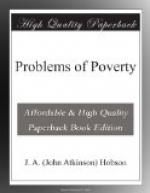Again, the growth of machinery makes industry more intricate. Manufacturers no longer produce for a small known market, the fluctuations of which are slight, and easily calculable. The element of speculation enters into manufacture at every pore—size of market, competitors, and price are all unknown. Machinery works at random like the blind giant it is. Every improvement in communication, and each application of labour-saving invention adds to the delicacy and difficulty of trade calculations. Hence in the productive force of machinery we see the material cause of the violent oscillations, the quiver of which never has time to pass out of modern trade. The periodic over-production and subsequent depression are thus closely related to machinery. It is the result upon the workman of these fluctuations that alone concerns us.
The effect of machinery upon the regularity of employment is both a difficult and a serious subject. Its precise importance cannot be measured. Before the era of machinery there often arose from other reasons, especially war or failure of crops, fluctuations which worked most disastrously on the English labourer. But in modern times we must look to more distinctively industrial causes for an explanation of unsteadiness of employment, and here the close competition of steam-driven machinery plays the leading part.
It must not, however, be supposed that machinery is essentially related to unsteadiness of work. The contrary is obviously the case. Cheap tools can be kept idle without great loss to their owner, but every stoppage in the work of expensive machinery means a heavy loss to the capitalist. Thus the larger the part played by expensive machinery, the stronger the personal motive in the individual capitalist to give full regular employment to his workmen. It is the competition of other machinery over which he has no control that operates as the immediate cause of instability of work. Thus the growth of machinery has a double and conflicting influence upon regularity of employment; it punishes capital more severely for each irregularity or stoppage, while at the same time it makes such fluctuations more violent.
Sec. 3. Displacement of Labour.—But the result of machinery which has drawn most attention is the displacement of labour. In every branch of productive work, agriculture as well as manufacture, the conflict between manual skill and machine skill has been waged incessantly during the last century. Step by step all along the line the machine has ousted the skilled manual worker, either rendering his office superfluous, or retaining him to play the part of servant to the new machine. A good deal of thoughtless rhetoric has been consumed upon the subject of this new serfdom of the worker to machinery. There is no reason in the nature of things why the work of attendance on machinery should not be more dignified, more pleasant, and more remunerative to the working-man




